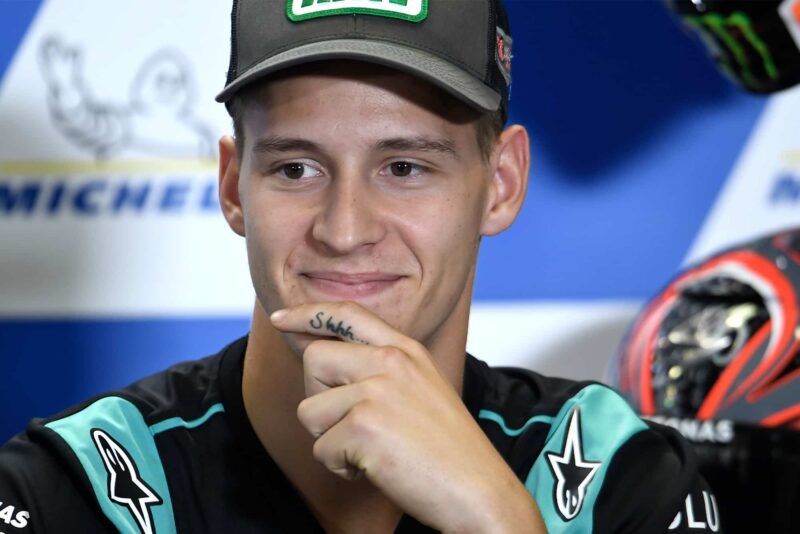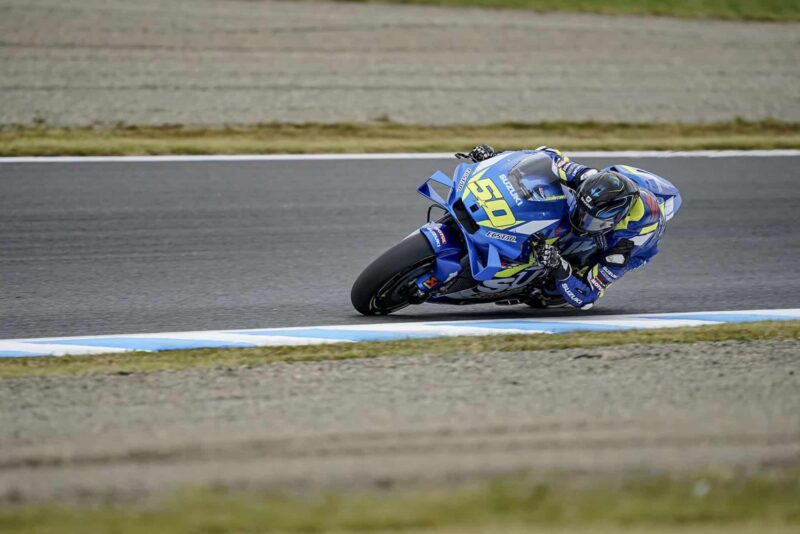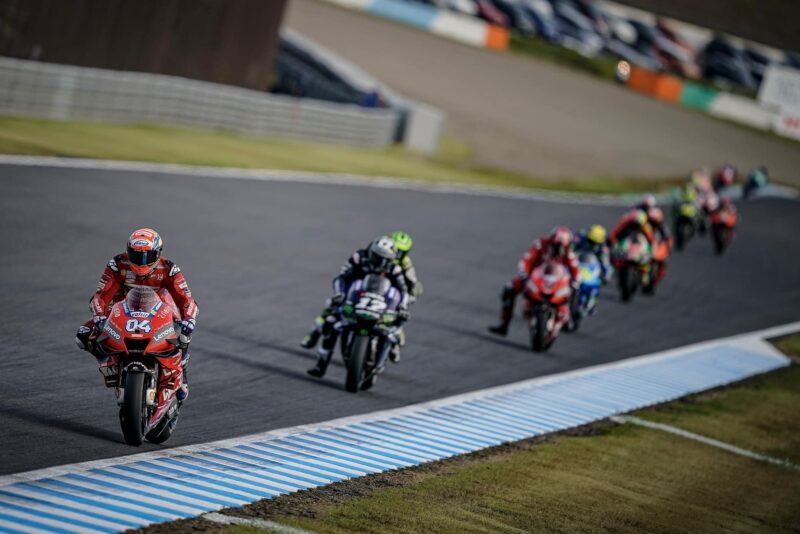The competition to sign Quartararo: Japanese MotoGP round-up
Why Quartararo is in no hurry to sign with Yamaha, how scrutineers checked Márquez’s fuel after he ran out of gas, why Suzuki’s test team got punished for testing and more from Motegi

Quartararo can afford to wait before signing a 2021 deal
Petronas SRT
Quartararo is playing a waiting game for 2021
Fabio Quartararo heads to Phillip Island this week aiming to score his first MotoGP win at a track where Yamaha’s YZR-M1 excels.
But the 20-year-old French rookie has no immediate plans to sign for the official Yamaha squad, despite increasing pressure from factory bosses to get his name on a contract.
There’s a simple reason for this. Quartararo’s value goes up every time he climbs aboard his Petronas YZR-M1, with his three second-place finishes from the last four races suggest he is now the second most talented rider on the grid.
Therefore, Honda’s rivals know they need the youngster if they want to try to end Marc Márquez’s domination. It is the job of Quartararo’s manager Eric Mahé to talk with these suitors to get his rider on the best bike and on the best money, once his current Petronas deal ends following the 2020 season.
“All the factories are interested in Fabio,” said Mahé, who has already secured his rider a top-spec YZR-M1 for next season. “Since May [when Quartararo first dazzled the paddock with pole position at Jerez] my first strategy has been to delay the 2021 negotiations. I don’t want to fix his future 18 months before the 2021 season and after he’s had only six months of MotoGP experience. The reasons are also technical, because it’s too early to understand what would be the best package for Fabio, and economical, because his value will increase.”
Nevertheless, Yamaha Racing director Lin Jarvis is still hopeful of getting Quartararo’s signature. “Fabio is happy riding the Yamaha, so I think the logical decision is to stay with Yamaha,” he said at Motegi.
How does MotoGP check the fuel of a bike that’s out of fuel?
How did MotoGP’s technical controllers test the fuel in Márquez’s RC213V after it ran dry on the slowdown lap at Motegi?
Formula 1 cars must finish each race with a minimum of one kilo of fuel in their tanks, of which about 20 millilitres are used for analysis. There is no minimum weight requirement in MotoGP, but the sample size is similar. About a dozen tests can be undertaken on each sample to confirm that all elements of the fuel comply with technical regulations.
“We only need around 20 millilitres for testing the fuel,” said MotoGP technical director Danny Aldridge. “So if a bike runs out of fuel on track, by the time it’s been returned to technical control the small amount of fuel that’s retained in the tank’s fire-retardant foam has drained to the bottom of the tank, which is enough for the tests. This was the case with Márquez’s bike at Motegi.”
Suzuki test team punished for testing

Suzuki was disqualified from FP1 and FP2 in Motegi
Suzuki
There was plenty of commotion in Sylvain Guintoli’s Suzuki garage on Saturday morning at Motegi. Suzuki’s test team had just been told that it couldn’t use the prototype 2020 GSX-RR engines it had used on Friday. Even worse, it had been disqualified from Friday’s FP1 and FP2 sessions for using those prototype engines.
Therefore Guintoli’s crew were in a panic, removing the prototype engines from his GSX-RRs and replacing them with 2019 engines. The mechanics worked miracles, getting him out on track five minutes into FP3.
“It was a mistake, a misinterpretation of the rules,” explained the Frenchman.
You could be forgiven for thinking that banning test teams from testing new kit is ridiculous. And you’d be right. But the MotoGP rulebook includes a technical regulation that forbids top factory test teams (those factories without concessions allowing them more engine development) from using anything but current homologated engines.
“It’s an MSMA rule which is all about cost-cutting,” said technical director Danny Aldridge. “Also, the factories don’t want a wild-card rider coming to an event with a much better engine that might interfere with the championship, so test teams have to use the same engine spec as the full-time teams. It’s the same with aero rules – the MSMA doesn’t want wild cards turning up and trying different aero packages all the time.”
Perhaps the regulations make sense, but do they really? Is a wild-card rider likely to turn up at a MotoGP round with ten per cent more horsepower than everyone else? No, that’s not going to happen, because the internal-combustion engine is already so highly developed that a one per cent gain is considered impressive.
And surely test teams should be encouraged to compete at races to swell the grid, to showcase new technology and generally improve the show?
Thankfully, MotoGP may consider dropping this engine regulation. “This will be discussed and probably will be changed in the future,” added Aldridge.
Now the most important question: is Suzuki’s 2020 prototype engine good enough to allow the factory to regularly compete with Honda and Ducati?
“The first signs are really good,” said Guintoli. “The thing is that we already have a very good bike with a really nice character, so we don’t want to change that. We just want to work at marginal gains – finding something a little better without compromising what we’ve already got.
“The best thing about an inline-four engine is that you can have a great chassis. We work a lot on making the engine match the character of the tyres, so it’s efficient over race distance, which it is.
“Of course, everyone wants more top speed, especially the manufacturers with inline-four engines, because raw power is the limitation of the inline-four. But from last year Suzuki already made a big step, so the bike is often faster than the Yamaha on top speed. Now we want more performance without compromising the bike’s good nature, which isn’t easy.”
Related content
Márquez: “It will be shoulders on the ground next!”
Marc Márquez revealed at Motegi that he started using his elbows as outriggers to ride around chatter problems in Moto2 and that he thinks younger riders may soon be using their shoulders to help them through corners.
“I first started using my elbows a little bit in 125s – starting with the right elbow,” said the eight-time world champion. “When I came to Moto2 one of the problems we had was a lot of front chatter. I had many crashes because of that high-frequency vibration from the front tyre, so I started using my elbows to save these crashes by helping the front tyre.
“When I arrived in MotoGP it was easier to use my elbows and it was something that helped a lot, so now I use both elbows and now every rider uses his elbows! The bikes, the tyres and everything have had a nice evolution over the years, so we can lean more and more and more.
“Now when I’m at home I watch kids riding minibikes around kart tracks and they are also using their elbows, so for sure in a few years they may be using their shoulders!”
Guintoli’s dual-pedal braking solution

Guintoli’s dual-pedal rear brake at Motegi
Mat Oxley
Dual-pedal brake levers aren’t entirely new in racing, but Suzuki test rider Sylvain Guintoli may have been the first rider to use the system in a MotoGP race on Sunday.
The concept is simple. A MotoGP bike’s rear brake isn’t only a tool to stop the bike. Riders also use the rear brake to adjust geometry in corners, to help the bike turn and to control acceleration on corner exits.
The problem, of course, is that riders can’t get their right foot to the brake when they’re leaning through right-handers; hence the current MotoGP fashion for hand-operated rear brakes. But reprogramming your brain to brake with the left hand instead of the right foot is a big ask, especially when one mistake braking from 200mph/320km/h could be your last. Hence the dual-pedal foot lever.
“The rear brake lever is in a stupid position because you can’t reach it when you need it in right turns!” said Guintoli. “With the dual pedal I don’t have to put my foot so far forward so it doesn’t drag on the track. Many riders now use a hand-operated brake. We thought about doing that, but for now we are trying this system. So far it works well.”
Ducati’s best race since Austria but problems remain

Ducati had a better outing at Motegi but its problems were still evident
Ducati
There’s nothing Ducati CEO Claudio Domenicali likes more than beating the Japanese factories on home ground. The Bologna factory has a great record at Motegi, with the Desmosedici scoring five Japanese GP victories with Loris Capirossi, Casey Stoner and Andrea Dovizioso on board.
There was no repeat success this time, just the usual realistic analysis from Dovizioso, who still looks back fondly at his stunning last-corner defeat of Márquez at Motegi 2017. “When I am old I will be even more surprised when I watch that race again,” he grinned.
The problem was nothing new. Although Ducati’s midseason frame upgrade has fixed the bike’s corner-entry turning the bike still struggles with corner-exit turning.
This was most noticeable when Dovizioso battled for third with Maverick Viñales. The clever Italian used the Ducati’s advantages in acceleration and braking to resist the Yamaha’s advances.
“I tried to close the door, stop the bike in the middle of the corner and then accelerate better, because our bike has better acceleration,” he said. “And I was fast because I took too many risks and I braked like a stupid rider; I lost the front too many times.”
“Back then the circuits were mostly road circuits, so we were riding between houses and shops and everything, so if you made a mistake you usually died.”
Dovizioso’s efforts to thwart Viñales also had the Spaniard making mistakes. He tried to pass the Ducati by using the M1’s superior corner-speed through the fast and flowing section from Turns Six to Eight, but he wasted his best chance with a mistake at the Turn Six right-hander, when he got alongside Dovizioso on the inside, so he was on the wrong side to pass him into the subsequent Turn Seven left. After that Vinales’ soft rear tyre gave up on him, while Dovizioso kept chasing after Quartararo, setting his fastest lap on the penultimate lap.
Team-mate Danilo Petrucci had another gloomy weekend, finishing ninth. “My problem at Misano and Aragon was the temperature of the rear tyre, so here we moved some weight towards the front and now the problem is the front – during the race the tyre was locking and collapsing, so I couldn’t stop the bike. Sincerely, I don’t know how to fix the bike.”
Sadly, the problem may not be the bike at all. Petrucci weighs 11 kilos more than Dovizioso, despite living on a starvation diet. Like Scott Redding, the Italian may become another victim of MotoGP’s reluctance to write a combined bike/rider minimum weight into the rule book.
Jack Miller was Ducati’s fastest qualifier at Motegi, using a lot of rear brake to get his GP19 turned through Motegi’s flowing section. The Aussie qualified on the second row and chased Márquez and Quartararo in the early stages, but his soft rear lost grip and he limped home in tenth after setting the fourth fastest lap. Miller now has a new electronics engineer in Lorenzo Goglia. His previous electronics engineer Marco Frigerio was given his marching orders before the Thai GP, after signing with Yamaha for 2020.
Redman celebrates Honda’s latest title and says good riddance to the bad old days

Márquez on his 2019 RC213V and Redman on his 1966 RC181
MotoGP
Honda flew six-times world champion Jim Redman to Japan to mark the company’s 60th anniversary of Grand Prix racing and celebrate its 25th premier-class constructors’ world title.
The 88-year-old legend has a special place in Honda’s history – he won the company’s debut 500cc Grand Prix at Hockenheim in 1966 and was leading the championship when he suffered career-ending injuries in a high-speed accident at Spa-Francorchamps. Honda had to wait another 17 years to finally win the crown.
At Motegi he was driven on a lap of honour before the MotoGP race, alongside old team-mate Kunimitsu Takahashi, who in 1961 became the first Japanese rider to win a GP, beating Redman by four-tenths of a second at Hockenheim.
Redman won 45 Grands Prix in the 1960s and is still Honda’s fourth most successful rider, after Márquez, Mick Doohan and Dani Pedrosa. At the 1964 Dutch TT he became the first rider to win three GPs in one day – the 125, 250 and 350cc races – totalling more than three hours and 230 miles (380km) of racing.
You might think that the more corporate and safer world of modern MotoGP might be anathema to a grizzled old warrior who risked his life every other weekend at Spa, the Isle of Man TT and other lethal street circuits; but no…
“I said, ‘what do we do, stop?’ He said, ‘no, make a will!’ Those days are gone forever and good riddance”
“I’m so happy to see that the riders no longer have to worry about the biggest thing we had to worry about in the 1960s,” said Redman. “Back then the circuits were mostly road circuits, so we were riding between houses and shops and everything, so if you made a mistake you usually died.
“We used to say to each other that if we survived until we were 30 then we’d had a good, long life. In my time I lost 64 friends through racing, and that was just the guys I knew, so there were loads of others dying.
“In 1962 we started the season with five of us that could win the 350 world championship. [MV rider] Gary Hocking said, ‘we’re going to kill each other this year because there are five us who know how to ride, but none of us know how to lose’. The rest of us said, we don’t want to talk about it!”
Honda lost two factory riders that year. “Tom Phillis was the first to die at the TT, then Bob McIntyre was killed a few weeks later,” added Redman.
Hocking was so stunned by the death of his friend Phillis that he asked MV Agusta to release him from his contract and he returned home to Africa, where he died testing a racing car.
“So Mike Hailwood and I were the only ones left. Mike said, ‘we’re on the shortlist now!’ I said, ‘what do we do, stop?’ He said, ‘no, make a will!’ Those days are gone forever and good riddance – it’s fantastic to see that these guys racing now are going survive.”
Honda won its first 500cc constructors prize at its first attempt in 1966 (when it achieved a unique full house of 500cc, 350cc, 250cc, 125cc and 50cc titles). Since then the title has been won by the NS500 and NSR500 two-strokes and the RC211V, RC212V and RC213V four-strokes.

